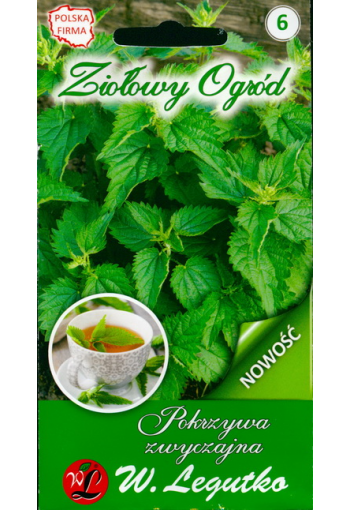Ex Tax: 1.95€
In Estonia, there are two useful types of nettles most common:Urtica dioica and Urtica urens. Stinging nettle is used in pharmaceuticals, perfumery and cooking. Stinging nettle grows near a person's dwelling, behind vegetable gardens and on wastelands, in floodplains among shrubs and in clearings, in alder forests and humid forests, choosing very fertile lands for themselves. The long rhizome gives life to new shoots, providing stable vegetative reproduction for this species.
Application and use.
Only a few types of nettle raw materials are used in the food industry and in medicine. The most popular medicine, where, in addition to other components, nettle extract is present is Allahol, which is used as a choleretic and laxative.
Nettle leaves are collected during their flowering period in mittens or gloves. Processed and crushed raw materials are dried for about a month under sheds, in attics or even on a balcony.
Nettle's raw materials are popular in cooking and in cosmetology. Greens are added to soups, cabbage soup and borscht, and fresh leaves are used as a filling in pies and vitamin salads. Nettle decoction is an excellent remedy for hair restoration, and extracts from raw materials are part of all kinds of creams and lotions for body care.
Used as animal feed.
What is nettle useful for and what medicinal properties does it have?
* the plant is rich in its multivitamin composition: ascorbic, pantothenic, formic, coffee, ferulic, P-coumaric acids
* vitamin K
* glycoside urticin - natural pacemaker
* tannins, protein and nitrogenous substances, carotenoids
* Amino acids and other elements necessary for the body.
Thanks to such a bunch of useful properties, nettle infusions improve the functioning of the digestive system, have a choleretic effect, normalize lipid metabolism and lower blood cholesterol levels. The presence of vitamin K gives the plant hemostatic and decongestant properties, and the plant protein lectin has an antitoxic property.
The chlorophyll present in nettle has an immunostimulating effect, helps to heal damaged tissues and enhances hair growth.
Animal studies have shown that infusions of nettle leaves can reduce sugar in diabetics, increase hemoglobin levels, and normalize the functioning of the cardiovascular system.
Nettle is used to treat boils and acne, and also as a remedy for rheumatism and gout. As a multivitamin remedy, it is part of many gastric, renal, antianemic and hemostatic preparations.
The healing properties of nettle are indispensable in the treatment of gynecological diseases.
To improve the composition of the blood and normalize the monthly cycle, in addition to the main treatment, different parts of the nettle in dry form and the juice of the plant are used.
Leaf infusion.
1 st. pour a spoonful of dry crushed leaves with 400 ml of water and cook for 10 minutes over low heat. Cool the infusion and filter it. Take 30 ml. 4 times a day for 3 days with heavy menstruation and uterine bleeding.
Tea with mint.
Mix 2 tbsp. spoons of dried nettle and mint leaves, add 3 litres of water and cook for 3 minutes. Ready to insist for about half an hour. Honey can be added to the filtered infusion.
Take 200 ml in the morning and evening for 10-14 days.
Since there is a lot of iron and B vitamins in nettle, taking funds based on it helps to increase the number of red blood cells and hemoglobin in the blood, then drinking such tea is indicated for anemia.
Decoction.
1 st. mix a spoonful of nettle leaves with burdock roots and pour 1 cup boiling water.
With the resulting decoction, wipe the heads after washing, lightly rubbing into the skin with baldness and seborrhea.
Being a natural storehouse of vitamins, nettle increases the body's resistance to various bacteria and strengthens the immune system, so it is used to treat skin diseases, heal wounds and promote hair growth.
* Stinging nettle is especially popular with vegetarians as it contains many micro and macro elements (eg iron).
* she is an assistant in procreation, as it promotes conception and the birth of children (the seeded aerial part of the plant helps women become pregnant, and the seeds and roots of nettle are a remedy for combating impotence and male infertility).
* nettle helps the liver to cope with toxins, it is a choleretic, hemostatic agent.
* Infusions and nettle juice accelerate the healing of wounds, ulcers and fistulas, as they stimulate regenerative processes in tissues (powder from dry nettle leaves or napkins soaked in its fresh juice are applied to purulent and weeping wounds).
Contraindications to the use of nettle.
* Nettle preparations are contraindicated in case of individual intolerance and may be incompatible with certain drugs (for example, nettle liquid extract, when taken simultaneously with antidepressants, can lead to depression of the central nervous system).
* nettle preparations are not recommended for patients with varicose veins or thrombophlebitis, as well as those suffering from polyps, cysts and any kind of gynecological tumors.
* It is strictly forbidden to drink even light nettle infusions for pregnant women, as this can cause uterine contractions and miscarriage.
Eng.: Common nettle, Stinging nettle. Bot. syn.: Urtica dioica L. subsp. galeopsifolia.











